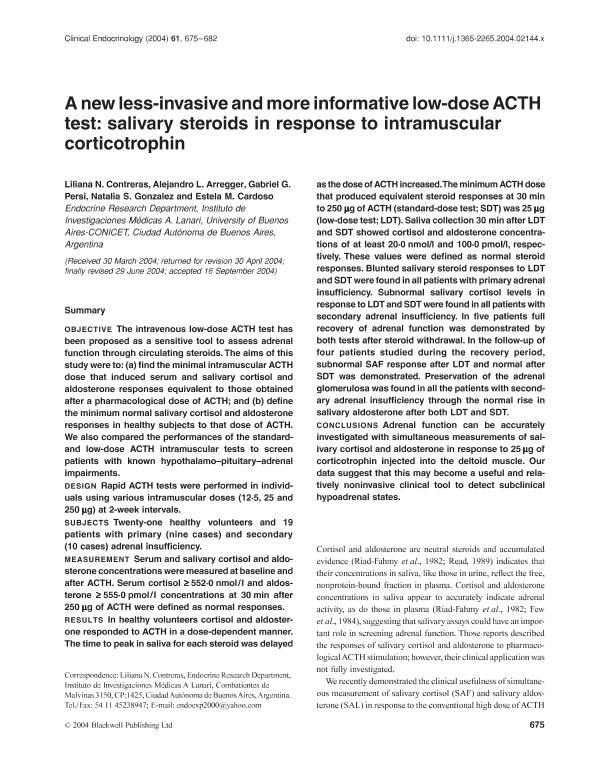Artículo
A new less-invasive and more informative low-dose ACTH test: salivary steroids in response to intramuscular corticotrophin
Contreras, Liliana Noemí ; Arregger, Alejandro Luis
; Arregger, Alejandro Luis ; Persi, Gabriel; Gonzalez, Soledad Natalia
; Persi, Gabriel; Gonzalez, Soledad Natalia ; Cardoso, Estela M. del Luján
; Cardoso, Estela M. del Luján
 ; Arregger, Alejandro Luis
; Arregger, Alejandro Luis ; Persi, Gabriel; Gonzalez, Soledad Natalia
; Persi, Gabriel; Gonzalez, Soledad Natalia ; Cardoso, Estela M. del Luján
; Cardoso, Estela M. del Luján
Fecha de publicación:
12/2004
Editorial:
Wiley Blackwell Publishing, Inc
Revista:
Clinical Endocrinology
ISSN:
0300-0664
Idioma:
Inglés
Tipo de recurso:
Artículo publicado
Clasificación temática:
Resumen
Objective: The intravenous low‐dose ACTH test has been proposed as a sensitive tool to assess adrenal function through circulating steroids. The aims of this study were to: (a) find the minimal intramuscular ACTH dose that induced serum and salivary cortisol and aldosterone responses equivalent to those obtained after a pharmacological dose of ACTH; and (b) define the minimum normal salivary cortisol and aldosterone responses in healthy subjects to that dose of ACTH. We also compared the performances of the standard‐ and low‐dose ACTH intramuscular tests to screen patients with known hypothalamo–pituitary–adrenal impairments. Design: Rapid ACTH tests were performed in individuals using various intramuscular doses (12·5, 25 and 250 µg) at 2‐week intervals. Subjects: Twenty‐one healthy volunteers and 19 patients with primary (nine cases) and secondary (10 cases) adrenal insufficiency. Measurement: Serum and salivary cortisol and aldosterone concentrations were measured at baseline and after ACTH. Serum cortisol ≥ 552·0 nmol/l and aldosterone ≥ 555·0 pmol/l concentrations at 30 min after 250 µg of ACTH were defined as normal responses. Results: In healthy volunteers cortisol and aldosterone responded to ACTH in a dose‐dependent manner. The time to peak in saliva for each steroid was delayed as the dose of ACTH increased. The minimum ACTH dose that produced equivalent steroid responses at 30 min to 250 µg of ACTH (standard‐dose test; SDT) was 25 µg (low‐dose test; LDT). Saliva collection 30 min after LDT and SDT showed cortisol and aldosterone concentrations of at least 20·0 nmol/l and 100·0 pmol/l, respectively. These values were defined as normal steroid responses. Blunted salivary steroid responses to LDT and SDT were found in all patients with primary adrenal insufficiency. Subnormal salivary cortisol levels in response to LDT and SDT were found in all patients with secondary adrenal insufficiency. In five patients full recovery of adrenal function was demonstrated by both tests after steroid withdrawal. In the follow‐up of four patients studied during the recovery period, subnormal SAF response after LDT and normal after SDT was demonstrated. Preservation of the adrenal glomerulosa was found in all the patients with secondary adrenal insufficiency through the normal rise in salivary aldosterone after both LDT and SDT. Conclusions: Adrenal function can be accurately investigated with simultaneous measurements of salivary cortisol and aldosterone in response to 25 µg of corticotrophin injected into the deltoid muscle. Our data suggest that this may become a useful and relatively noninvasive clinical tool to detect subclinical hypoadrenal states.
Palabras clave:
Low-dose ACTH test
,
salivary cortisol
,
salivary aldosterone
Archivos asociados
Licencia
Identificadores
Colecciones
Articulos(IDIM)
Articulos de INST.DE INVEST.MEDICAS
Articulos de INST.DE INVEST.MEDICAS
Citación
Contreras, Liliana Noemí; Arregger, Alejandro Luis; Persi, Gabriel; Gonzalez, Soledad Natalia; Cardoso, Estela M. del Luján; A new less-invasive and more informative low-dose ACTH test: salivary steroids in response to intramuscular corticotrophin; Wiley Blackwell Publishing, Inc; Clinical Endocrinology; 61; 6; 12-2004; 675-682
Compartir
Altmétricas



